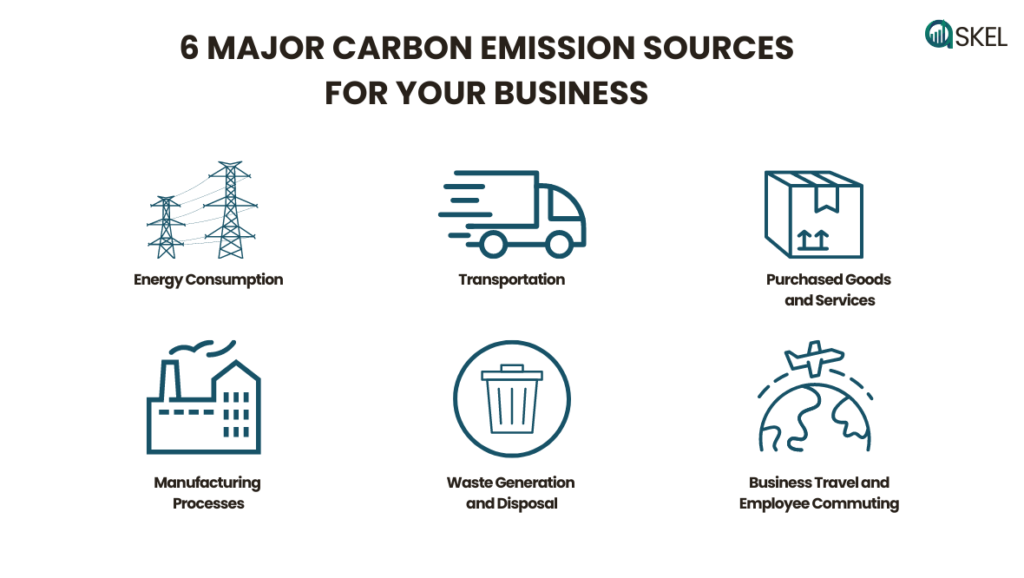6 Major Carbon Emission Sources for Your Business

An insight into 6 major sources of GHG emissions that have a significant impact on the carbon footprint of your business.
It is common knowledge that in order to contribute towards combating climate change, businesses must understand and address their carbon emissions. An emission source from a business’s perspective refers to any activity, process, or operation that releases greenhouse gases (GHGs) into the atmosphere. Identifying and managing these sources is crucial for reducing a company’s carbon footprint in addition to achieving its sustainability goals.
The biggest sources of emissions for most businesses typically include energy consumption, which involves the use of electricity and fuel for heating, cooling, and powering equipment. Transportation emissions arise from the movement of goods and services, significantly contributing to a business’s carbon output. Purchased goods and services represent the carbon footprint associated with the production and delivery of items a company buys. Manufacturing processes often release substantial amounts of GHGs, especially in industries reliant on heavy machinery and chemical reactions.
Waste generation and disposal also contribute to emissions, with landfills and incineration releasing methane and carbon dioxide. Business travel and employee commuting, encompassing flights and other forms of travel with associated stays for work purposes, and the daily travel of employees to and from work, represents another significant emission source.
In this article we dig deep into these key GHG emission sources and what are some common measures that businesses adopt to reduce emissions from them.
1. Energy Consumption
Emissions from energy consumption refer to the greenhouse gases released when businesses use electricity, gas, and other fuels to power their operations. This includes heating, cooling, lighting, and running machinery or electronic devices. The combustion of fossil fuels for energy production is a significant source of carbon dioxide (CO2) and other greenhouse gases, making energy consumption a major contributor to a company’s overall carbon footprint.
To reduce emissions from energy consumption, companies can adopt several strategies. First, switching to renewable energy sources such as solar, wind, or hydro power can significantly cut down emissions. Second, improving energy efficiency through upgraded equipment, LED lighting, and better insulation can reduce the amount of energy needed for daily operations. Third, implementing energy management systems to monitor and optimise energy use can identify areas for further savings. Lastly, encouraging behavioural changes among employees, such as turning off lights and equipment when not in use, can also contribute to lowering energy-related emissions.
2. Transportation
Emissions from transportation refer to the greenhouse gases emitted during the movement of goods and services, both upstream and downstream. From a business perspective, this includes emissions from both company-owned vehicles and third-party logistics providers. These emissions are primarily from burning fossil fuels in vehicles such as cars, trucks, planes, and ships, releasing significant amounts of carbon dioxide (CO2) and other pollutants into the atmosphere.
To reduce emissions from transportation, companies can adopt several strategies. First, investing in electric or hybrid vehicles for company fleets can drastically cut down on fossil fuel use. Second, optimising logistics by planning more efficient routes and consolidating shipments can reduce the number of trips required.

3. Purchased Goods and Services
Emissions from purchased goods and services refer to the greenhouse gases emitted throughout the supply chain of the products and services a business buys. This includes emissions from the production, transportation, and disposal of these goods and services. For a business, this could involve everything from office supplies and manufacturing materials to outsourced services and IT infrastructure. These emissions are often categorised as Scope 3 emissions, which are indirect and occur outside the company’s direct control but within its value chain.
To reduce emissions from purchased goods and services, companies can implement several strategies. First, businesses can choose suppliers that have strong sustainability practices with efforts in place to lower their carbon footprint. Second, opting for products made from recycled or sustainable materials can significantly reduce emissions. Third, engaging in bulk purchasing can minimise the frequency of deliveries and thus lower transportation emissions. Finally, companies can implement a comprehensive supplier code of conduct that emphasises reducing environmental impact, thereby encouraging all partners to adopt greener practices.
4. Manufacturing Processes
Emissions from manufacturing processes include those from the use of energy, chemical reactions, and the operation of machinery. For businesses engaged in manufacturing, these emissions can be significant, stemming from activities like material extraction, product assembly, and finishing processes. These emissions are often direct (Scope 1) emissions, as they occur from sources owned or controlled by the company.
To reduce emissions from manufacturing processes, companies can take several steps. First, adopting energy-efficient technologies and machinery can significantly cut energy consumption and associated emissions. Second, optimising production processes to reduce waste and improve efficiency can lower overall emissions. Lastly, implementing a rigorous maintenance schedule for equipment can ensure that machinery operates at peak efficiency, further reducing emissions.
5. Waste Generation and Disposal
Emissions from waste generation and disposal include emissions from waste disposal via landfills, incineration, and/or recycling, in addition to emissions from waste transportation. For businesses, these emissions can arise from production waste, office waste, and the disposal of obsolete products or materials.
To reduce emissions from waste generation and disposal, companies can adopt several strategies. First, encouraging waste reduction at the source through better design and manufacturing processes can minimise the amount of waste produced. Second, choosing eco-friendly disposal methods and working with sustainable waste management providers can further reduce the environmental impact of business waste.
Furthermore, managing and reducing energy use and GHG emissions can be a catalyst to improved efficiencies and can pave the way to more environmentally benign energy technologies. Such reduction measures are therefore beneficial to long-term company success in their own right and should be supported by shareholders on their own merits. Many companies already recognise the importance of energy measures as a key indicator of their production efficiency and environmental impacts.
The GHG Indicator: UNEP Guidelines for Calculating Greenhouse Gas Emissions for Businesses and NonCommercial Organisations
6. Business Travel and Employee Commuting
Emissions from business travel and employee commuting include the greenhouse gases produced by the transportation methods used for work-related trips, stays and daily commutes. This includes flights, car rentals, and train journeys for business travel, overnight stays in hotels or other similar accommodation, as well as personal vehicles, public transportation, and any other modes of transport that add to emissions for employee commuting. These activities collectively contribute to a company’s carbon footprint and can be substantial, especially for businesses with extensive travel needs or large workforces.
To reduce emissions from business travel and employee commuting, companies can: first, promote remote work and virtual meetings thereby significantly cutting the need for travel. Second, encouraging the use of public transportation, carpooling, and biking for daily commutes can reduce the number of single-occupancy vehicles on the road. Third, implementing flexible work hours can help employees avoid peak traffic times, thereby reducing idle time emissions. Finally, providing incentives for using electric vehicles or offering shuttle services can further minimise the carbon footprint associated with business travel and commuting.


